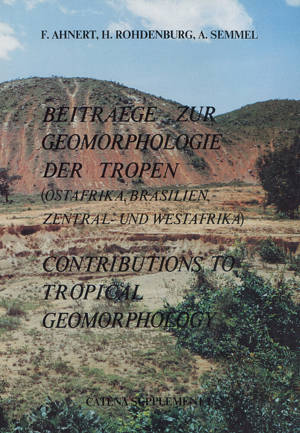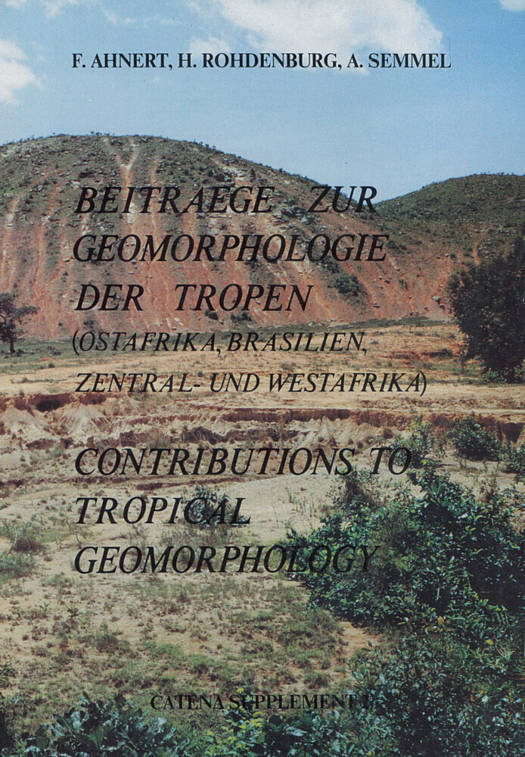
- Retrait gratuit dans votre magasin Club
- 7.000.000 titres dans notre catalogue
- Payer en toute sécurité
- Toujours un magasin près de chez vous
- Retrait gratuit dans votre magasin Club
- 7.000.0000 titres dans notre catalogue
- Payer en toute sécurité
- Toujours un magasin près de chez vous
Beiträge zur Geomorphologie der Tropen
(Ostafrika, Brasilien, Zentral- und Westafrika)
F. Ahnert, H. Rohdenburg, A. Semmel
60,45 €
+ 120 points
Description
The inselberg region of Machakos is located in the south-eastern part of the highlands of Kenya, on the boundary between the exposed pre-Cambrian basement and its Cenozoic volcanic cover. The morphoclimate of this region is controlled by the seasonal fluctuation of the Southeast Trade Winds which are the principal suppliers of moisture from the Indian Ocean. The area has two rainy seasons separated by a short (Jan.-Feb.) and a long (May-Oct.) dry season. Mean annual precipitation varies within the region from more than 1300 mm to less than 600 mm, predominantly as a function of relief and exposure. The year-to-year rainfall variation of individual stations has ratios ranging from about 3:1 for the more humid stations to about 8:1 for the dryer ones. As a remarkable rule it was found that the mean precipitation per rainy day is higher at the arid stations than at the humid ones, but that at any individual station it is higher in wet years than in dry ones - i.e. the spatial and temporal patterns do not correspond. Magnitude-frequency analysis for Machakos indicates about 12 days per year with more than 25 mm rainfall (an approximate threshold for overland flow), one day per year with more than 65 mm, and one day in five years with more than 90 mm. Magnitude-frequency analyses of shorter-duration high intensity rains corroborate the finding that overland flow events of relatively low magnitude and moderate frequency are cumulatively most effective as agents of denudation. Quantitative analysis of size parameters of about sixty inselberg systems shows a highly significant relationship between the total height of inselberg-plus-pediment and the width of the pediment. This is interpreted as the expression of a developmental sequence: as the inselberg side slope retreats and the pediment thus expands, the inselberg summit is being lowered. The downwearing of the inselberg is accompanied by a progressive change in slope form from complex to mainly convex to concave; the last remnant of the inselberg is usually a tor. The sequence is probably initiated by stream incision, with pedimentation beginning as formation of valley-side pediments. The area contains examples of several stages of the separation of inselbergs from a larger upland by stream dissection. Direct signs of the erosive work of the streams are in-valley divides and elbows of capture, V-shaped valleys and potholes scoured by quartz pebbles that are supplied from stone lines on the slopes. The pediments do not possess a deeply weathered regolith. Instead there is an apparently thin sedimentary cover with occasional exposed bedrock flats. This and the absence of shield inselbergs suggest that the pediments of this region are not shaped by the process of double planation today. Some of the inselbergs rise through the cover of Miocene volcanics and are thus of pre-Miocene or early Miocene age. Others lie adjacent to a Miocene lava plateau at a lower elevation than the latter and are thus of post-Miocene age. Still others have more recently been separated from larger uplands by fluvial erosion that is still active today, and some have not quite been separated yet. It seems, therefore, that inselberg formation must have taken place at various times since the mid-Tertiary. The fluvial dissection that initiated it apparently occurred in two phases of which the younger one is still in progress. Their causation seems to be tectonic rather than climatic. The Miocene volcanics and the present positions of stream profiles permit a rough estimate of long-term denudation and erosion rates: inselberg slopes have retreated in the order of 100-200 mm per 1000 years, their summits have been worn down in the order of 50 mm per 1000 years, and knickpoints of streams have migrated headward in the order of 5-10 m per 1000 years. At the conclusion of the paper an attempt is made to simulate the essential aspects of inselberg development in this region by mean
Spécifications
Parties prenantes
- Auteur(s) :
- Editeur:
Contenu
- Nombre de pages :
- 140
- Langue:
- Allemand
- Collection :
- Tome:
- n° 2
Caractéristiques
- EAN:
- 9783510653430
- Format:
- Livre broché
- Dimensions :
- 170 mm x 240 mm
- Poids :
- 360 g

Les avis
Nous publions uniquement les avis qui respectent les conditions requises. Consultez nos conditions pour les avis.






